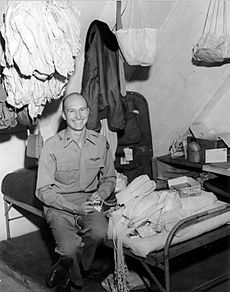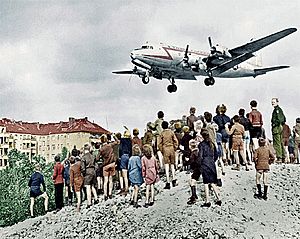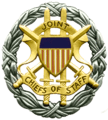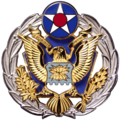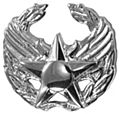Gail Halvorsen facts for kids
Quick facts for kids
Gail Halvorsen
|
|
|---|---|
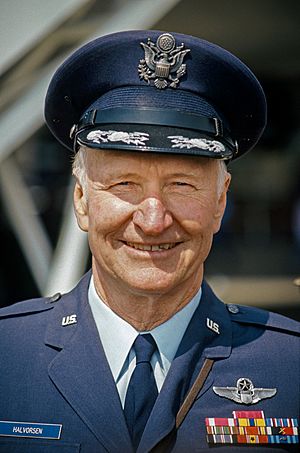
Halvorsen c. 1983
|
|
| Nickname(s) | Uncle Wiggly Wings Berlin Candy Bomber |
| Born | October 10, 1920 Salt Lake City, Utah, U.S. |
| Died | February 16, 2022 (aged 101) Provo, Utah, U.S. |
| Allegiance | United States of America |
| Service/ |
U.S. Army Air Forces United States Air Force |
| Years of service | 1942–1974 |
| Rank | |
| Unit | Air Force Material Command |
| Commands held | 7350th Air Base Group Berlin Tempelhof Airport 6596th Instrumentation Squadron |
| Battles/wars | World War II Berlin airlift |
| Awards | Legion of Merit Meritorious Service Medal Congressional Gold Medal Order of Merit (Germany) |
| Alma mater | Utah State University University of Florida |
| Spouse(s) |
Alta Jolley
(m. 1949; died 1999)Lorraine Pace
(m. 2004) |
| Website | Official Website: https://www.thecandybomber.org/ |
Gail Seymour Halvorsen (born October 10, 1920 – died February 16, 2022) was a high-ranking officer and pilot in the United States Air Force. He became famous as the "Berlin Candy Bomber" or "Uncle Wiggly Wings". He earned these nicknames for dropping candy to German children during the Berlin Airlift from 1948 to 1949.
Halvorsen grew up on farms in Utah. He always dreamed of flying. He got his private pilot's license in 1941. Then he joined the Civil Air Patrol. In 1942, he joined the United States Army Air Forces. He was sent to Germany in July 1948 to fly planes for the Berlin Airlift.
During the airlift, Halvorsen flew large cargo planes. He started "Operation Little Vittles" on his own. This was a secret plan to drop candy to the children of Berlin. He made tiny parachutes for the candy. Soon, his idea became very popular. People all over the United States helped. Halvorsen's operation dropped over 23 tons of candy. He became a national hero.
Halvorsen received many awards for "Operation Little Vittles." One important award was the Congressional Gold Medal. He continued his military and humanitarian work for 25 more years. He even dropped candy in other countries like Bosnia-Herzegovina and Japan. He retired from the Air Force in 1974. He had flown for over 8,000 hours.
Early Life and Becoming a Pilot
Gail Seymour Halvorsen was born in Salt Lake City, Utah, on October 10, 1920. He grew up on small farms in Idaho and Utah. He finished high school in 1939. He also went to Utah State University for a short time.
In September 1941, he earned his private pilot's license. Around the same time, he joined the Civil Air Patrol. In May 1942, Halvorsen joined the United States Army Air Forces. He trained to be a pilot in Oklahoma. After his training, he flew transport planes in the South Atlantic. On July 10, 1948, he was sent to Germany. His mission was to fly for "Operation Vittles," which is now known as the Berlin Airlift.
Operation "Little Vittles" and the Candy Drops
During the Berlin Airlift, Lieutenant Halvorsen flew C-54 cargo planes. These planes brought supplies to the people of Berlin, who were starving. One day in July, Halvorsen was filming planes at Tempelhof Airport. This was the main airport for the airlift. He saw about thirty children waiting behind a fence. He went to talk to them. The children had almost nothing.
Halvorsen remembered what they told him: "When the weather gets so bad that you can't land, don't worry about us. We can get by on a little food, but if we lose our freedom, we may never get it back." Halvorsen was very touched. He gave the children two sticks of gum. The kids broke the gum into tiny pieces and shared it. Those who didn't get any sniffed the wrappers.
Halvorsen felt sad that he couldn't give them more. He promised them that the next day, he would drop gum from his plane. A child asked, "How will we know it's your plane?" Halvorsen replied that he would wiggle his wings. He had done this for his parents when he first got his pilot's license.
That night, Halvorsen and his crew gathered their candy rations. They made three small parachutes from handkerchiefs. They tied the candy to these parachutes. The next morning, during their regular supply drop, they also dropped the candy. They did this once a week for three weeks. Each time, more children waited at the fence.
When his commander, Lieutenant General William H. Tunner, heard about it, he loved the idea. He ordered it to become an official operation. They called it "Operation Little Vittles." It was named after the main airlift, "Operation Vittles." The official candy drops began on September 22, 1948.
Support for "Operation Little Vittles" grew quickly. First, Halvorsen's friends helped. Then, his whole squadron joined in. News of the candy drops reached the United States. Children and candy makers across America started sending candy. By November 1948, so much candy was arriving that Halvorsen needed help. A college student named Mary C. Connors helped organize the project. She worked with candy companies to prepare the candy and tie the handkerchiefs.
With so much support, "Little Vittles" pilots dropped candy almost every other day. Children all over Berlin received sweets. They sent back many drawings and thank-you letters. The American candy bombers became known as the Rosinenbomber (Raisin Bombers). Halvorsen himself had many nicknames, like "Uncle Wiggly Wings," "The Chocolate Uncle," and "The Chocolate Flier."
Operation "Little Vittles" lasted from September 22, 1948, to May 13, 1949. Halvorsen returned home in January 1949. He passed on the leadership to his friend, Captain Lawrence Caskey. In total, "Operation Little Vittles" dropped over 23 tons of candy. This was done using more than 250,000 tiny parachutes.
Family Life and Later Years
Gail Halvorsen's work with "Operation Little Vittles" made him famous around the world. He married Alta Jolley in April 1949. They had five children. Their family lived in different parts of the United States and Germany because of Halvorsen's military jobs.
After he retired in 1974, the family moved to Provo, Utah. From 1976 to 1986, Halvorsen worked at Brigham Young University. He and Alta were active in The Church of Jesus Christ of Latter-day Saints. They served as missionaries in London, England, and St. Petersburg, Russia. Alta passed away in 1999.
Five years later, Halvorsen married his high school sweetheart, Lorraine Pace. They lived on a farm in Spanish Fork, Utah. In January 2021, he recovered from COVID-19.
Gail Halvorsen died in Provo, Utah, on February 16, 2022. He was 101 years old.
His Career in the Air Force
After returning home in 1949, Halvorsen decided to stay in the Air Force. He earned two degrees in Aeronautical Engineering from the University of Florida. He worked on developing cargo aircraft. He also worked on space projects, like the Titan III rocket program.
From 1970, Halvorsen was the Commander of the 7350th Air Base Group. This was at Tempelhof Central Airport in Berlin, the same airfield he flew to every day during the Berlin Airlift. He retired on August 31, 1974. He had served for 31 years and flown for over 8,000 hours.
His Lasting Impact
Halvorsen's work with "Operation Little Vittles" had a huge impact. It helped people in the United States and around the world. Even after retiring in 1974, he continued to serve his community and country.
After Halvorsen died in 2022, Berlin's mayor, Franziska Giffey, said, "Halvorsen's deeply human act has never been forgotten."
Awards and Honors
Halvorsen received many awards for his kindness. In 1949, he received the Cheney Award from General Hoyt S. Vandenberg. This award recognized his humanitarian actions with "Operation Little Vittles."
Other important awards include the Legion of Merit and the Congressional Gold Medal. The Congressional Gold Medal is the highest award Congress can give to a civilian. He was also inducted into the Airlift/Tanker Hall of Fame. The United States Air Force even named a new aircraft loading vehicle after him. They also created the Col. Gail Halvorsen Award for excellent air transportation support.
Halvorsen's actions greatly improved relations between Germany and America. In 1974, he received Germany's highest award, the Großes Bundesverdienstkreuz (Grand Cross of the Order of Merit of the Federal Republic of Germany). Many German schools are named after him, including one in Berlin and the Gail S. Halvorsen Elementary school in Frankfurt. He often appeared on German television with the children (now adults) who received his candy. In 2002, he carried the German national placard at the 2002 Winter Olympics in Salt Lake City.
Continuing Humanitarian Work
Halvorsen continued his candy drops even after retirement. He re-enacted his famous candy drops for anniversaries of the Berlin Airlift. In 1989, he dropped candy to Berlin children, including grandchildren of those he had helped before. He also participated in a European tour with a C-54 plane, celebrating the 50th anniversary of the airlift.
Halvorsen believed in using candy drops to spread goodwill in other countries. In 1994, he dropped hundreds of candy bars over Bosnia-Herzegovina. He also organized a large drop over Kosovo in 1999. He performed candy drops in Japan, Guam, and Albania. In 2003 and 2004, he suggested similar drops over Baghdad. He wanted them to be a "ray of hope" for Iraqi children. Since then, the U.S. military has dropped toys and soccer balls to children in Iraq, inspired by his actions.
Images for kids
See also
 In Spanish: Gail Halvorsen para niños
In Spanish: Gail Halvorsen para niños


